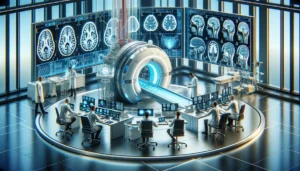The advent of Neuralink, spearheaded by Elon Musk, heralds a new era in the intersection of neuroscience and technology. It may also prove to be transformative implications for individuals suffering from brain injuries. This article explores the potential of Neuralink’s cutting-edge brain-machine interface (BMI) technology to revolutionize treatment and rehabilitation for brain injury patients. Furthermore, it highlights its capacity to restore function, enhance communication, aid rehabilitation, and offer novel monitoring and treatment options.
At the core of Neuralink’s mission lies developing highly sophisticated BMIs that enable direct communication between the human brain and external devices. Neuralink seeks to capture neural signals with unprecedented precision and minimal invasiveness by implanting tiny, flexible electrodes into the brain. This technological breakthrough stands to benefit brain injury patients in several profound ways.
Firstly, Neuralink promises to restore lost functions. Brain injuries result in loss of mobility or sensory perception due to damaged neural pathways. Neuralink’s technology aims to bypass these damaged connections, allowing patients to control prosthetic limbs or other devices directly with their thoughts. This capability restores independence and significantly improves the quality of life for those affected.
Secondly, Neuralink offers a lifeline for individuals facing severe communication barriers. Conditions such as ALS or stroke can leave patients with full cognitive capabilities trapped in bodies that no longer respond. Neuralink’s BMI could decode neural signals associated with language or intent. Thus enabling these individuals to communicate through text or speech-generating devices. This breakthrough has the potential to break down the walls of isolation, offering a voice to those who have been silenced.
Furthermore, Neuralink plays a crucial role in rehabilitating brain injury patients. By providing real-time feedback on neural activities, the technology enhances the effectiveness of therapeutic exercises designed to regain motor skills or cognitive functions. This feedback loop accelerates the recovery process. It also tailors rehabilitation to the specific neural patterns of the individual, making it more efficient and personalized.
Moreover, Neuralink extends its benefits beyond immediate functional restoration and rehabilitation. Its ability to monitor brain activity continuously opens new avenues for the early detection and treatment of neurological disorders. This continuous monitoring could lead to breakthroughs in understanding. In addition, it will help with managing conditions such as epilepsy, depression, and Parkinson’s disease, offering hope for millions affected worldwide.
However, while the potential of Neuralink is vast, it is accompanied by a need for rigorous clinical trials and ethical considerations. The safety, efficacy, and long-term impacts of implanting BMIs in humans must be thoroughly evaluated. Privacy, data security, and the potential for cognitive enhancement raise important ethical questions that must be addressed as part of Neuralink’s development.
In conclusion, Neuralink and it’s brain injury possibilities represent a pioneering leap forward in merging human cognition with technology. Its potential to revolutionize the treatment and rehabilitation of brain injury patients is unparalleled. Furthermore, it offers new hope for restoring function, enabling communication, facilitating rehabilitation, and advancing neurological treatments. As Neuralink moves from experimental stages to practical applications, it promises to improve lives. Moreover, it can potentially fundamentally alter the landscape of neurological healthcare.






